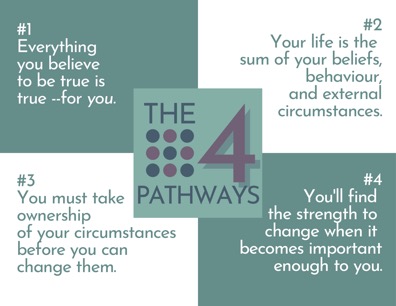Rael Kalley’s proprietary method is called The 4 Pathways.
The 4 Pathways are like a guidance system that helps you reach your goals.
When you encounter a challenge or difficulty, review the Pathways. One of them will hold the knowledge you need to help get you back on your path.

#1 – Everything you believe to be true is true for you.
I ran a leadership development program for a company we’ll call DevCorp. The program culminated in a participants making a presentation to DevCorp’s executive leadership team.
At the beginning of the year-long program, the participants were panicked at the idea of having to make such a high-stakes presentation. By the time a year passed, they were not only ready but eager to get in front of their bosses. So what changed?
Simply their belief that they could do it. Once they wrapped their heads around the idea that they could stand up in front of their corporate leaders and pitch an idea of their own, they had checked off the most difficult part of the task.
When you struggle to meet a goal, ask yourself if you really believe you can do it.
If you’re bogged down by negative beliefs, replace them with positive ones.
Use affirmations to help change limiting beliefs.
Vivamus integer non suscipit taciti mattis etiam
#2 – Your life is the sum of your beliefs, behaviour, and external circumstances.
Molly was a 38-year-old financial planner with her own business. She was very successful and had already made enough money to retire before she was even 40 years old.
She came to see me because despite her success in business, she couldn’t seem to get her health on track. She had been diagnosed with prediabetes and her doctor had expressed the need for her to make exercise a consistent part of her life. How could someone so successful struggle with something so straightforward?
Pathway #2 explains Molly’s problem perfectly. She was frustrated and annoyed that her body let her down, and believed she did not have any spare time to add exercise. Molly did not take responsibility for the fact that her own actions and beliefs were combining with external circumstances (genetics, luck, etc) to create this problem and it wouldn’t go away until she addressed that.
There is no single reason things “are the way they are.”
External circumstances factor in, but they aren’t the whole picture.
#3 – You must take ownership of your circumstances before you can change them.
Frank was headed for divorce. His wife Kathy had told him she was no longer interested in working things out. Frank loved Kathy and didn’t want to split up, but he didn’t know how to get their 45-year marriage back on track.
“She has totally changed,” he told me, “We used to have a ton in common and now we barely have anything to talk about.” After their 20-year-old twin sons had moved out, Kathy developed a number of new hobbies. She became a fitness buff and started working on a detailed family tree. Frank was hurt and bewildered that she would rather go to the gym or research her genealogy than watch a hockey game or go golfing with him.
By placing all the blame for their problems on Kathy’s new interests, Frank was not able to address the reasons they had grown apart. He needed to examine his own role in their problems before he could even begin to fix them.
The common denominator of all your challenges is you.
There is no such thing as having a problem but not having a role in that problem.
#4 – You will find the strength to change when it becomes important enough to you.
Ellis was on track to become one of the youngest vice presidents ever at the large energy company he’d worked at since completing his MBA. He knew he would need his department to achieve its targets in order to secure the promotion. The problem was a key employee on his team. Steph was difficult and unenthusiastic. Unfortunately, she was responsible for an important piece of the business. Plus she had been there for more than 20 years, it would be a nightmare trying to replace her.
For almost a year, Ellis and I talked about how he needed to let Steph go. It wasn’t until he was passed over for a vice president job that he realized his unwillingness to do the work of replacing Steph was getting in the way of his dream. He put Steph on a performance improvement program and ultimately found her a soft landing in another position more suited to her. He then hired a superstar candidate to replace her.
If you’ve tried to change in the past and it didn’t seem to stick, that’s okay.
When you finally, deeply understand the importance of the change, you’ll stick with it.
